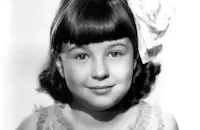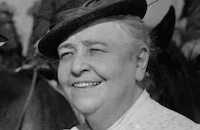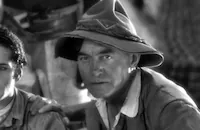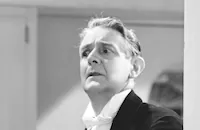Little Miss Nobody
Brief Synopsis
Cast & Crew
John Blystone
Jane Withers
Jane Darwell
Ralph Morgan
Sara Haden
Harry Carey
Film Details
Technical Specs

Synopsis
Judy Devlin, a mischievous girl in the Sunshine Foundling Home, gets the best of grocer Harold Slade and his son Herman. After everyone enjoys a Thanksgiving meal with turkeys Judy stole from Slade, Mrs. Sybil Smythe and her son Junior look over the little orphan girls to adopt a sister and playmate for Junior. He makes nasty comments about all the girls until he sees Mary Dorsey, whom he insists on having his mother adopt despite her dislike of him. Judy and Mary are friends who have pledged to be adopted together. To discourage Junior, Judy starts a fire drill and turns the water hose on him. Hiding afterwards in the cellar, Judy finds the boxes containing the clothing in which the orphans were originally found, including her own. Later, Mrs. Martha Bradley, patroness of the home, threatens Judy with reform school if she does not behave. While Judy is cleaning the office, Mr. Gerald Dexter, district attorney for Springfield, arrives. Ten years ago, his pregnant wife left him after he prosecuted a relative of hers. He shows a crest that the infant born to his wife may have worn on her clothing, and Judy recognizes it as the same as the one on her outfit in the cellar. As she is about to explain, Mary calls her, and Judy goes to switch the clothing to save Mary from the Smythes. Everyone thinks that Judy was trying to make them believe she was Dexter's daughter, and she accepts the blame, sacrificing herself for Mary. Judy is sentenced to two years in reform school, but she escapes on the way there. When she is hit by a bicycle and a policeman insists on accompanying her home, she leads him to a pet shop whose owner she calls her uncle. The proprietor is John Russell, who avoided a prison sentence, and he listens sympathetically to Judy's story. Criminal Dutch Miller knows that John was a bank robber named Phil Ormsbey back in Kansas. Seeking a hideout, Dutch moves in on the happy John and Judy. Judy goes to the Dexter estate to see Mary and promises to return the next evening when her father will be away. Learning of this, Dutch knocks out John and drives Judy to the house, which he attempts to rob. The girls discover him, and John, arriving in time to stop Dutch, shoots him in a struggle. John then goes on the lam, and although Judy refuses to talk, John is caught. Examining the duplicate records on Judy's case, Dexter sees a notation about the crest found on her clothing when she was a baby. He realizes what has happened, and father and daughter are reunited.

Director
John Blystone
Cast

Jane Withers

Jane Darwell

Ralph Morgan

Sara Haden

Harry Carey
Betty Jean Hainey
Thomas Jackson
Jackie Morrow
Jed Prouty
Claudia Coleman
Donald Haines
Clarence H. Wilson
Lillian Harmer
Francis Ford
Jerry Tucker
Gloria Mitzi Carpenter
Elaine Von
Jacqueline Taylor
Dorothy Gray
Rex Downing
Johnnie Pirrone Jr.
Fay Simon
Warner Weidler
Carmencita Johnson
Lois Verner
Wally Albright
Mary Gordon
Robert E. Homans
Stanley Blystone
Paul Kruger
Billy Butts
Arthol Washington
Selmer Jackson
Eddie Hart
Nora Cecil

Arthur Housman
C. J. Tryon Dog Act

Leonard Carey
Alexander Pollard
Ben Hendricks
Almeda Fowler
Raymond Brown
Gladden James
Herbert Sorkin
Gloria Roy
Crew
Sidney Bowen
Lou Breslow
Paul Burger
Sidney Clare
Duncan Cramer
Al Degaetano
Edward Eliscu
Donald Flick
Bert Glennon
Samuel Kaylin
William Lambert
Jack Stern
Harry Tobias
Henry M. Tobias
Sol M. Wurtzel

Film Details
Technical Specs

Quotes
Trivia
Notes
The working title of this film was originally Public Nuisance No. 1 before a particular subject had been chosen for Jane Withers; when the short story was obtained, the working title became The Matron's Report, and Public Nuisance No. 1 became reserved as the title for the next Withers picture. According to the Twentieth Century-Fox Produced Scripts Collection at the UCLA Theater Arts Library, Frances Hyland wrote a treatment for this film in November 1934. It is not known whether material from that treatment was used in the finished film. Paul Stanton is listed as a cast member in Hollywood Reporter production charts, but his participation in the final film has not been confirmed. In 1929, Fox produced a film based on the same source entitled Blue Skies, directed by Alfred Werker and starring Helen Twelvetrees (see AFI Catalog of Feature Films, 1921-30; F2.0493).












